This text is motivated by a question I had under my YouTube video about a ferrata tour in the Dolomites. I thought it could be useful to have the answer as a post for reference.
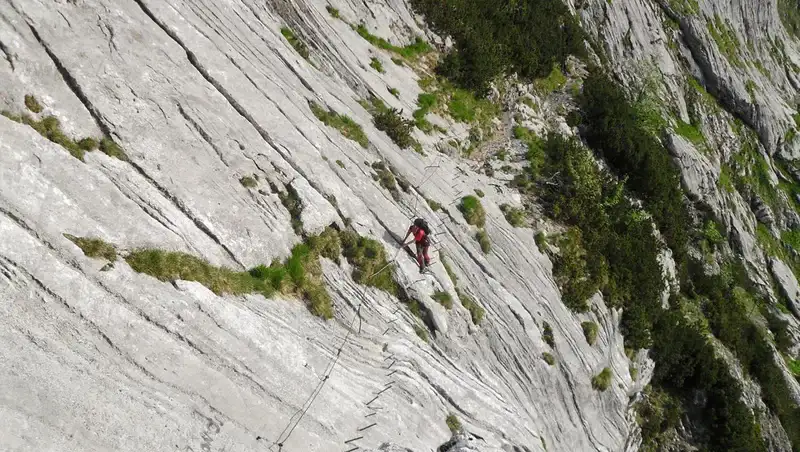
By the way, the mentioned question you can find here. Now, falls on a via ferrata route are serious but manageable with the right gear and techniques. Here’s what you need to know:
Protective Gear
A full via ferrata kit is essential. This includes a climbing helmet, a harness, and a Y-rope which is a lanyard system with two carabiners attached to a shock-absorbing system that is itself attached to the harness. This kit helps reduce impact force if you fall.
Anchor Points
Via ferrata routes typically have a steel cable secured to the rock with anchor points spaced every few meters. You clip into this cable. The picture below shows a cable under the summit of Razor in Slovenian Alps.
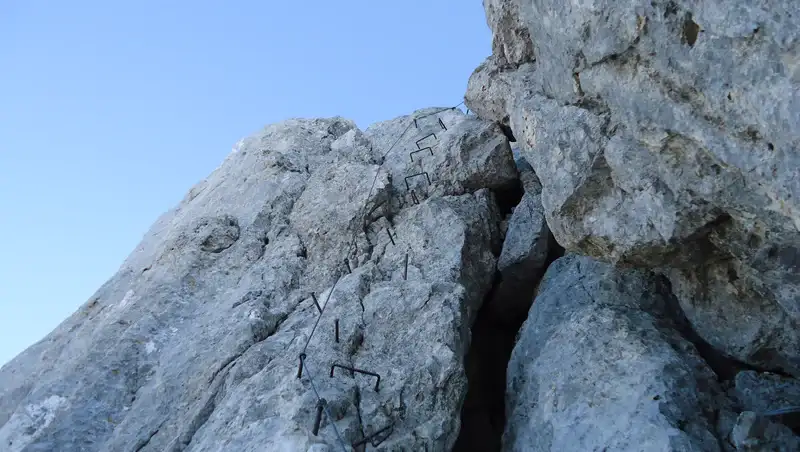
If you fall, the anchors stop you from tumbling down the mountain. You might slide a short distance to the nearest anchor, but the system prevents a long fall.
How the Shock Absorber Works
The shock absorber in your lanyard slows your fall, reducing the force on your body. This keeps injuries to a minimum. Without it, even a short fall could lead to serious injuries.
Proper Clipping Technique
Always keep one carabiner attached to the cable. As you move, unclip and reclip one at a time, keeping yourself connected. This practice is key to safety, ensuring that even if you slip, you are always anchored.
It is advised to clip the carabiners in opposite directions, see the picture, this is from my Tofana di Mezzo tour.
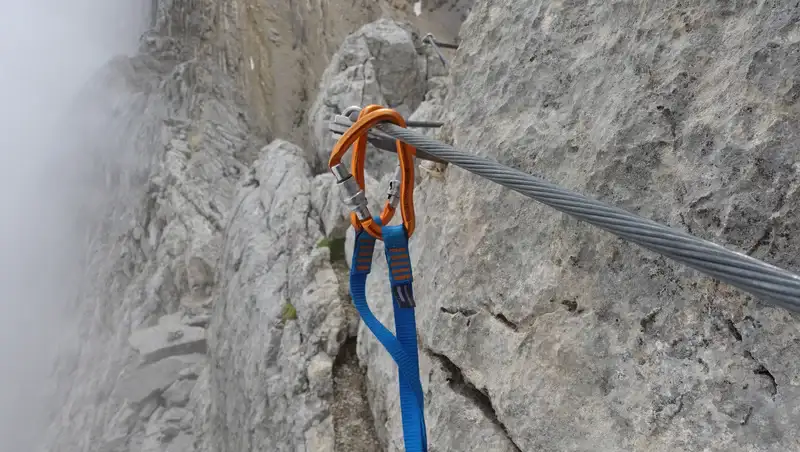
Common Sense and Caution
Being physically prepared, assessing weather conditions, and knowing your limits are vital. Taking these precautions lowers the chances of falls significantly.
Via ferrata routes are challenging, but with all the elements in place, they are designed to keep you secure.
However, cables may be damaged, see the picture below, this is from my ferrata Goitan tour on Jof Fuart in Julian Alps, Italy. What you see is an impact damage due to a falling rock. So do not just assume that it is always completely safe, inspect cables visually if you can.
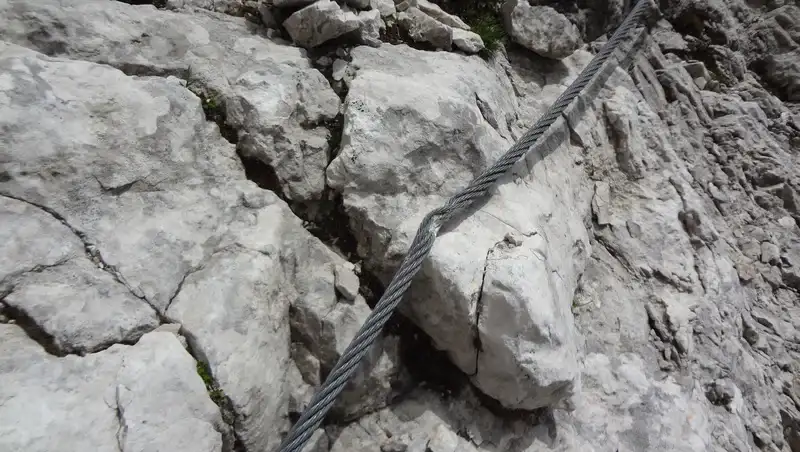
Knowing the risks and how safety gear works allows you to climb with confidence and enjoy the experience.
How Many Times Can a Climbing Harness and Y-Rope Withstand a Fall?
When climbing via ferrata, the reliability of your harness and Y-rope (lanyard) is crucial. These components are designed to withstand significant forces, but they have limits.
Here’s a breakdown of the lifespan and fall tolerance for harnesses and Y-ropes, based on manufacturer guidelines and safety research.
1. Climbing Harness Lifespan and Fall Tolerance
Lifespan: Most climbing harness manufacturers, including Petzl and Black Diamond, recommend replacing a harness after 5 years of occasional use or 1-3 years of regular or intensive use.
This lifespan considers factors like exposure to UV light, dirt, and wear from friction, which all weaken materials over time.
Fall Tolerance: Harnesses are primarily designed to hold the weight of a climber during normal usage, not repeated major falls. For typical via ferrata falls, which are shorter than free climbing falls, a well-maintained harness should hold up well over time.
However, a single severe fall can cause internal or external damage that may not be visible. In such cases, a harness should be carefully inspected or replaced.
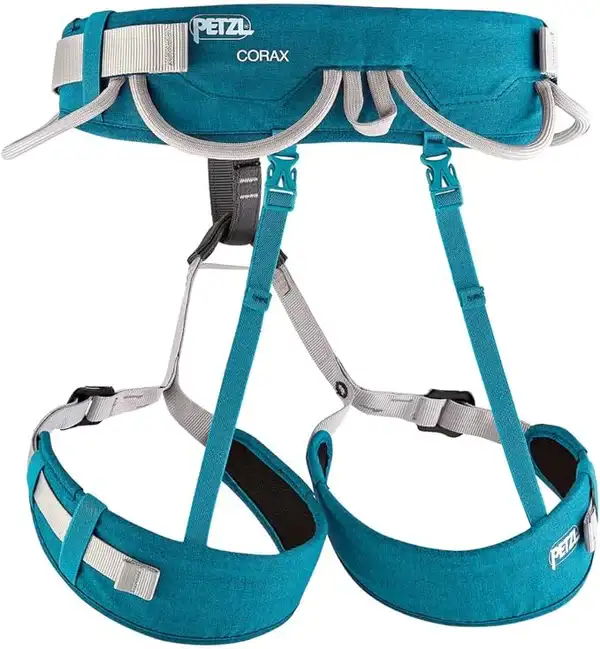
Note that a climbing harness is mostly gender-specific but the example in the picture, the PETZL Unisex Adult Corax is an exception.
2. Y-Rope (Lanyard) with Shock Absorber: Fall Limitations
Design and Testing: Via ferrata Y-ropes are specially made to handle short but intense falls by including a shock absorber, which spreads out the force of a fall to minimize impact.
These Y-ropes are usually tested to withstand one major fall (factor 5-6). After a significant fall that deploys the shock absorber, the lanyard should be replaced immediately because its fall-arrest capacity is exhausted.
Single Major Fall Policy: Manufacturers like Edelrid and Petzl advise that Y-ropes with a deployed shock absorber are no longer safe for further use.
After one significant fall, even if it was a short distance, the lanyard must be replaced, as its capacity to absorb future falls will be compromised.
Minor Falls: If you experience only minor slips (where the shock absorber doesn’t deploy), the Y-rope may still be usable. However, frequent minor falls can gradually degrade the material, and periodic inspections are important.
Any visible wear, tears, or fraying are signs that it’s time for a replacement.
The example in the picture is the Petzl Scorpio Vertigo Lanyard Climbing Set. With equipment which is designed to protect your life, it is best to go for such a reliable brand. But many more items of this type you can find among Amazon bestsellers.
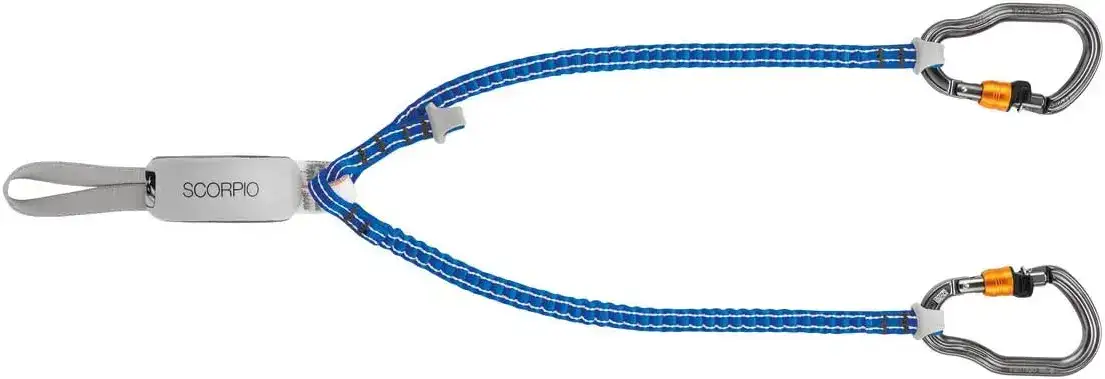
3. Inspection Guidelines
After a Major Fall: Any equipment involved in a fall where the shock absorber deploys should be inspected closely. Visible signs of stress, such as stretched fabric, frayed stitching, or damaged buckles, indicate the need for replacement.
Routine Inspections: Even without major falls, both the harness and Y-rope should be checked before each use. Over time, exposure to sunlight, water, and friction weakens the materials, potentially reducing their effectiveness.
4. Summary of Replacement Rules
Harness: Replace every 1-3 years if used regularly, or 5 years for occasional use. Replace immediately after a major fall if any damage is suspected.
Y-Rope: Replace after one major fall (shock absorber deployed). Inspect and consider replacing after frequent minor falls or signs of wear.
Sources
- Petzl Technical Notice: Via Ferrata Equipment Usage and Inspection Guidelines.
- UIAA (International Climbing and Mountaineering Federation) Safety Standards for Lanyards and Harnesses.
- Edelrid Lanyard Usage Guide and Fall Tolerance Information.
Manufacturers and safety organizations emphasize that while equipment is designed for safety, regular inspection and replacement are crucial for any equipment that has been exposed to significant stress.
Limitations of a Climbing Helmet: Lifespan and Fall Tolerance
Climbing helmets are vital for protecting your head from rockfall, impact with the rock face, or other injuries. Like harnesses and Y-ropes, climbing helmets have specific limits on their lifespan and impact tolerance.
The example in the picture, the BLACK DIAMOND Half Dome Helmet, is one of the most popular on Amazon. It comes with a testing certificate.
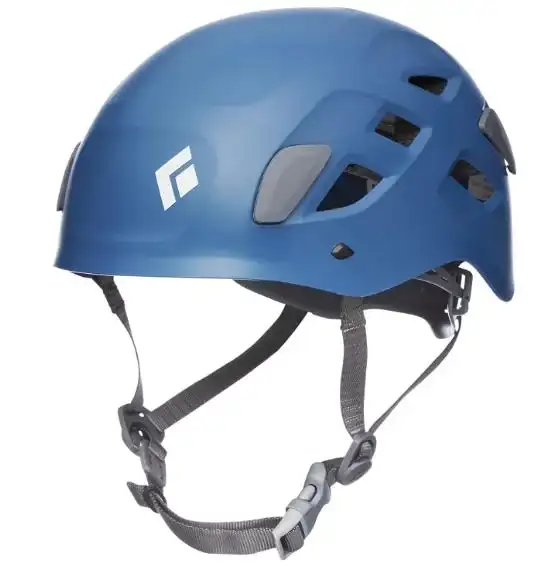
1. Lifespan of a Climbing Helmet
Typical Lifespan: Most helmet manufacturers, including Petzl, Black Diamond, and Mammut, recommend replacing helmets every 5-10 years of regular use, depending on the model, material, and frequency of use.
For heavy use, replacement may be advisable closer to the 5-year mark.
Material Degradation: Over time, the materials in helmets degrade due to UV exposure, temperature changes, and general wear. For example, exposure to sunlight and extreme temperatures weakens the shell and inner foam, reducing its ability to absorb impact.
2. Fall or Impact Tolerance
Single Significant Impact Rule: Most climbing helmets are designed to protect against a single major impact.
After a major impact — such as a fall where your head hits the rock, or being struck by a heavy falling rock — the helmet should be replaced. Even if there is no visible damage, internal structures may be compromised, reducing future protection.
Visible Damage: If there is visible damage to the helmet, such as cracks in the outer shell, dents, or any deformation of the inner foam, it is no longer safe to use. Even small cracks can compromise the structural integrity of the helmet.
3. Inspection and Maintenance
Regular Inspection: Before each climb, check the helmet for any cracks, dents, or signs of wear. Also, inspect the chin strap and any adjustable parts for signs of weakening or fraying.
Storage: Proper storage helps extend the life of a helmet. Store it in a cool, dry place away from direct sunlight and avoid placing heavy objects on top of it.
4. Summary of Replacement Rules
- Replace every 5-10 years for regular use.
- Replace immediately after a significant impact (fall, rockfall).
- Replace if visible damage (cracks, dents, or deformations) is present.
Sources
- Petzl and Black Diamond technical notices on helmet lifespan and replacement.
- UIAA Safety Standards for climbing helmets.
Climbing helmets provide essential protection, but they are not meant to last indefinitely, particularly after absorbing impacts. Regular inspection and timely replacement ensure they continue to offer reliable safety on each climb.
Related: Some Common Terms in Via Ferrata
Cable: The steel cable is the main safety line on a via ferrata. You clip into it to stay anchored while climbing.
Piton: A metal spike embedded into the rock. Pitons secure the cable to the rock wall and serve as anchor points. You have already seen them in the pictures above, but here is one more, and yes it is as vertical as you see:
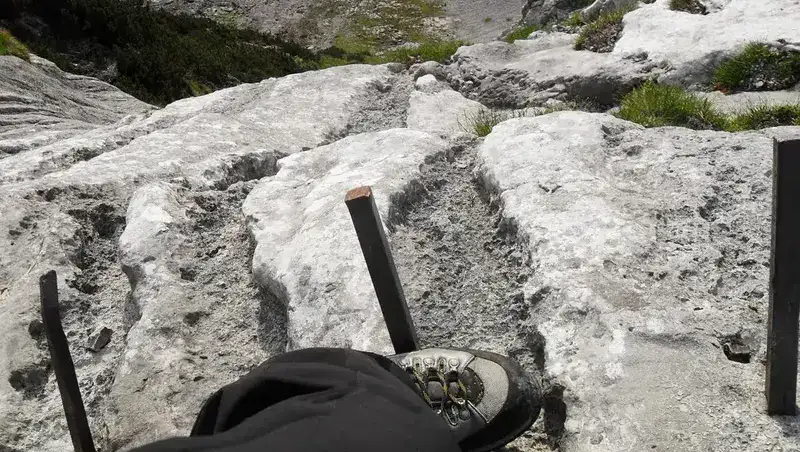
Ladder: Fixed ladders are often added to steep sections, the example below is under the summit of Conturines. They give climbers footholds for stability and help tackle more challenging terrain.
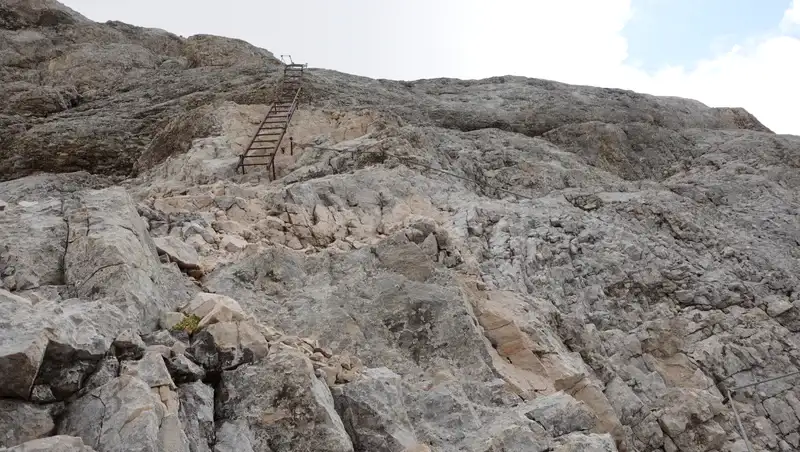
Stemples: These are iron rungs drilled into the rock, similar to ladder rungs, providing grips and steps on vertical sections. See one great example below.

Bridges: Some routes include hanging bridges, adding an element of exposure and thrill. One great example is shown in the picture:
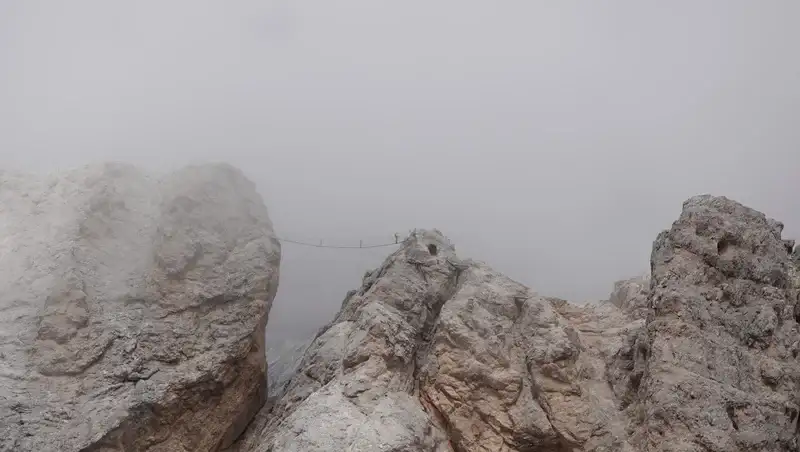
Thank you for reading. Subscribe to my weakly newsletter and stay informed, the subscription form is given below.
Leave a Reply